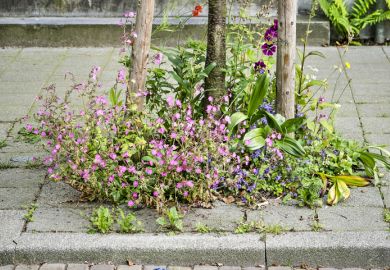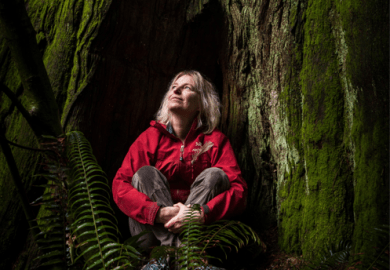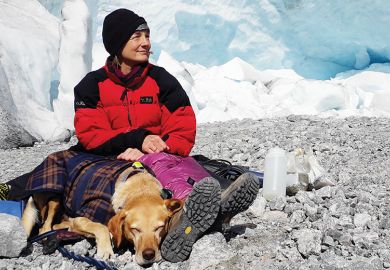There are probably at least 20 volcanoes erupting on earth as you read this review. It is clear from their increasing frequency as subjects of television and cinema presentations that active volcanoes pull an audience. Universal Pictures gave us the movie Dante's Peak featuring Pierce Brosnan as the alarmed volcanologist trying to convince authorities of the reawakening of a dormant volcano; BBC's Horizon introduced the term super-volcano into the lexicon; and a string of documentaries and international news stories, including the prominent ongoing eruption of the Soufrière Hills volcano on Montserrat, have brought startling images of volcanic violence into the living room.
It is not clear how this upsurge in interest has arisen, but it is not the result of any obvious increase in the incidence of volcanic activity. Although eruptions are more common than realised - they occur at a rate of about 60 a year - there are no more now than in past decades.
From a volcanological perspective, the documentaries and films have been entertaining and educational (colleagues of mine have shown Dante's Peak to their undergraduates to promote discussion on the scientific and social issues it raises, notwithstanding its liberal application of artistic licence). They also coincide with an immense excitement in the discipline that we can now really achieve things with volcanology - we can use it to predict eruptions, to understand the geological evolution of the earth's interior and crust, to test the sensitivity of the earth system to sudden climate forcing. These, and many other important topics, are the substance of the Encyclopedia of Volcanoes .
The study of volcanoes has a long, distinguished heritage punctuated by scientific controversies and revolutions, and, of course, several earth-shaking eruptions. Inspired by the spectacular highlight of the Grand Tour - a nocturnal display of magmatic pyrotechnics from Vesuvius's summit - many European scientists of the 18th and 19th centuries conjectured on the origins of volcanism and its relationship to the evolution of the earth's crust. A period classic is George Poulett Scrope's 1825 publication: "Considerations on volcanoes, the probable causes of their phenomena, the laws that determine their march, the disposition of their products, and their connexion with the present state and past history of the globe; leading to the establishment of a new theory of the Earth".
Volcanology marched on with contributions from detailed, and occasionally hazardous, field studies in the first half of the 20th century at active volcanoes. In the past few decades, advances in laboratory techniques, observation capabilities (notably thanks to satellites that can safely observe even the most excessive of volcanic violence from orbit) and rigorous experimental and theoretical modelling have brought us to the point that about 800 enthusiastic delegates will turn up at international volcanological conferences. These will include atmospheric scientists, petrologists, volcano observatory staff, geochemists, geomorphologists, ecologists, sociologists, psychologists and others, indicating just how multifaceted the subject has become. It is a tribute to this encyclopedia that it conveys this strong multi and interdisciplinarity.
The chief editor, Haraldur Sigurdsson, is an experienced volcanologist widely respected in the volcanological community for important and diverse contributions to the field. He opens the encyclopedia with an overview of volcanoes and their impacts, and a resumé of the historical and philosophical development of volcanology. The book then consists of 82 chapters written by more than 100 volcanologists and other scientists, divided into nine principal sections. These are ordered in a loose progression beginning with the generation of molten rock (magma) within the earth, and its eruption on to the surface and into the atmosphere. These subdivisions more or less work, though some chapters do not sit very comfortably under their headings and several blur the distinction between process and hazard.
Part one examines the source region of magmas - the earth's mantle - and the physical and chemical processes that can cause regions of it to melt and, ultimately, feed volcanoes. It synthesises the latest understanding of the origins of volcanism, which remained a contentious topic until quite recently. Other chapters focus on magma's ascent towards the earth's surface, its accumulation in magma chambers, and the physical and chemical properties that influence its behaviour beneath and, on eruption, above the earth's surface.
In common with many other natural systems, volcanoes follow power-law statistics. The smallest eruptions are very common, the largest ones very rare. Part two of the encyclopedia examines the quantification of these relationships between sizes and frequencies of eruptions, in historical and geological contexts.
Volcanology is no stranger to nomenclature - the discipline is strewn with abstruse jargon and dry classification schemes that confuse volcanologists. An example is the division of the spectrum of volcanic eruption "styles" - that is, the physical nature of an eruption as it might be described by an eyewitness (the height reached by an eruption column, the duration of eruption, the area affected and so on). Sensibly, in parts three and four, the encyclopedia divides all the shades of eruption style into two groups, making the broad distinction between comparatively peaceful lava effusions and more violent explosive eruptions.
Volcanoes are not necessarily calm between eruptions, and these sections of the encyclopedia also document some non-eruptive phenomena. Because they accumulate on steep slopes, and are at least partly composed of loose ash and cinders, volcanic deposits can easily redistribute themselves. For example, heavy rains can generate mud flows that run down valleys draining the volcano, sometimes threatening communities tens of kilometres away. More rarely, whole flanks of a volcano can collapse under gravity, launching crushing avalanches of volcanic debris capable of covering hundreds of square kilometres.
More important, parts three and four also detail the broad spectrum of ash and lava products from these different phenomena and the landforms they produce. Understanding the link between process and deposit assumes particular significance in the assessment of hazards at little-known volcanoes because the rock record represents an archive of data that can be interpreted in terms of eruption styles that might recur and the areas that would then likely be affected. This involves field and laboratory work to characterise the nature of deposits and their magnitudes. By combining this information with dating of ash layers and lavas by radiocarbon and other techniques, it is possible to determine the intervals between eruptions and to reach conclusions about the timing and style of future eruptions. These can inform decisions about the development of areas vulnerable to volcanism.
Differences in planetary evolution, gravitational acceleration and atmospheric composition and pressure result in some interesting geomorphological and compositional differences among volcanoes across the solar system. Part five of the encyclopedia explores the extraterrestrial volcanoes, notably those of Mars, Venus and Jupiter's moon Io. It also looks at the ancient volcanic features of our own moon, and "cryo-volcanism" of the icy outer planets and moons of the solar system.
Part six, "Volcanic interactions", refers primarily to the chemical reactions between volcanic gases and the rocks and groundwater they meet after their escape from magma chambers. Two scholarly chapters in this section explain the complex chemistry of volcanic gases and the crater lakes they sometimes bubble into. Other chapters consider the significance of these volcanic volatiles for the formation of economic ore deposits and geothermal systems.
The hazards posed by different eruption styles are considered in part seven. Not all the chapters fit within the category: they include one on volcano seismology, which is more focused on surveillance issues; one on the global-scale atmospheric and climatic impacts of the aerosol veils injected into the upper atmosphere by large eruptions, which has more to do with the earth-system perturbations of volcanism; and one on global geochemical cycles of sulphur and carbon, which could have been included in part six.
The more obviously hazard-related chapters include one on the increasingly significant threat to aviation posed by volcanic ash clouds, which can intersect air corridors thousands of kilometres downwind; reviews of ash, mud and lava flow risks; and a summary of medical perspectives on volcanic injuries. An interesting contribution details the colonisation and ecological succession on new volcanoes such as Krakatau and Surtsey.
Volcanoes probably never erupt without warning. Sometimes, however, only sensitive geophysical or geochemical surveillance can detect the telltale signals, and then much will rest on the interpretation of the data-stream obtained. Volcano monitoring aims to provide information that can help to constrain the precise timing of future eruptions and their probable nature. Surveillance is maintained during an eruption to assist prediction of the cessation of activity. A problem often encountered is that volcanoes send out mixed signals - some seemingly presaging eruption, others indicating quiescence. The principal approaches to volcano monitoring, including seismology, geodesy and gas geochemistry, are reviewed in part eight.
Although great advances in understanding how volcanoes work have been made in the past two decades, eruption prediction is still based in great part on "pattern recognition". The most effective predictions have been possible where various monitored parameters all changed at much the same time. Notable successes have been achieved in Japan, the United States, Indonesia, the Philippines and Montserrat.
But it is not sufficient merely to predict an eruption. Scientists arguably have the most informed opinions concerning what a restless volcano might do in the next few days or weeks, and they have a responsibility to communicate their understanding of the situation unambiguously to civil-defence authorities, the media and the populations at risk. Effective hazard management requires that the many people involved, who might ordinarily represent quite disparate self and public interests, cooperate with the single purpose of preventing disaster. The best monitoring data in the world are worthless if only the scientists believe or understand them. It is good to see, therefore, four chapters in part eight that examine these broader issues of dissemination of volcano information, and management of volcanic risks before and during crises.
The final part of the encyclopedia groups some diverse contributions on economic and cultural aspects of volcanoes, including geothermal exploration and exploitation, the formation and properties of volcanic soils, applications of volcanic rocks (from bathroom pumice to cathedral building stone) and volcano tourism. Two excellent chapters by the chief editor conclude the body of the encyclopedia, documenting volcanism in art, literature and film. A useful appendix cataloguing historically active volcanoes completes the volume.
No other publication can compare with this encyclopedia. Although several new titles in volcanology appear every year, these tend to be introductions to the subject or edited volumes on specific topics such as the physics of volcanic clouds or monitoring techniques. It is true that much of the individual material could be dug out of review papers, monographs and textbooks, but nowhere is so much put together in a single volume.
Furthermore, there is information here that could not be found elsewhere. The encyclopedia consists of a single volume of some 1,400 pages. Weighing in at 3.6kg, this is more a tome for the university or home library with a strong reading desk to hand than for a long flight. Anyone with more than a passing interest in volcanology would greatly value it, and the book represents an outstanding resource for undergraduates in geology, geography and environmental sciences, as well as a number of cognate disciplines. The self-contained nature of the chapters renders the text particularly digestible, and the thematic format offers infinitely more than a dictionary-style encyclopedia of defined terminology. The authors come from an international pool and do not represent any particular school of thought.
Inevitably, some doctrines will be overturned or revised in years to come, but this does not diminish the considerable shelf-life the encyclopedia will enjoy. As an authoritative synthesis of the discipline, it hangs together well as a whole: the individual contributions are well integrated and cross referenced. The book also benefits from clear and accurate illustration, referencing and indexing, and a handsome overall standard of production. It is excellent value as well as an exceptionally good read.
Some publicity was generated by a recent report on asteroid and comet impacts, requested by the UK minister for science. These rare events carry such severe consequences that the global risk is surprisingly and worryingly high. The largest volcanic eruptions are capable of wreaking comparable planetary-scale havoc and may occur more frequently than collisions with large "near-earth objects". Super-volcanic eruptions could devastate the global economy.
There has never been a better time to learn about volcanoes and their impacts. There has never been a better single reference on the subject to assist.
Clive Oppenheimer is lecturer in geography, University of Cambridge.
Encyclopedia of Volcanoes
Editor - Haraldur Sigurdsson, Bruce Houghton, Stephen R. McNutt, Hazel Rymer & John Stix
ISBN - 0 12 643140 X
Publisher - Academic Press
Price - £65.00
Pages - 1,417
Register to continue
Why register?
- Registration is free and only takes a moment
- Once registered, you can read 3 articles a month
- Sign up for our newsletter
Subscribe
Or subscribe for unlimited access to:
- Unlimited access to news, views, insights & reviews
- Digital editions
- Digital access to THE’s university and college rankings analysis
Already registered or a current subscriber?



